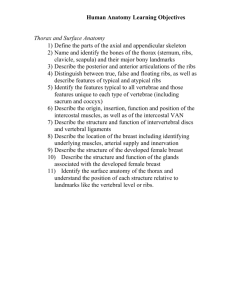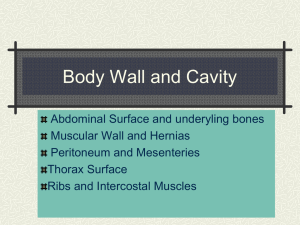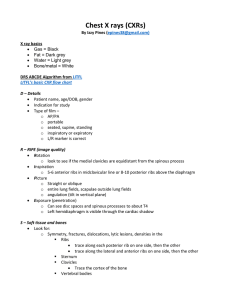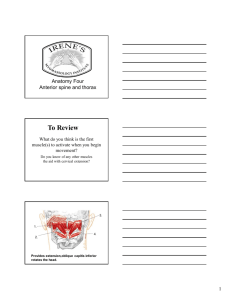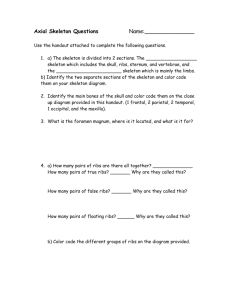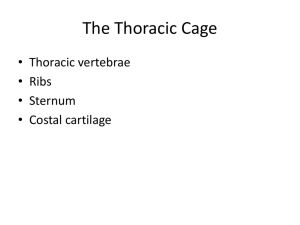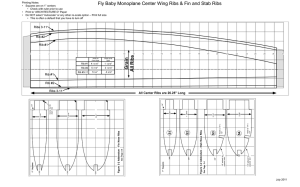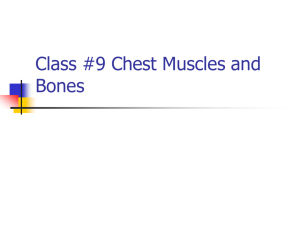CH 13 REVIEW QUESTIONS
advertisement
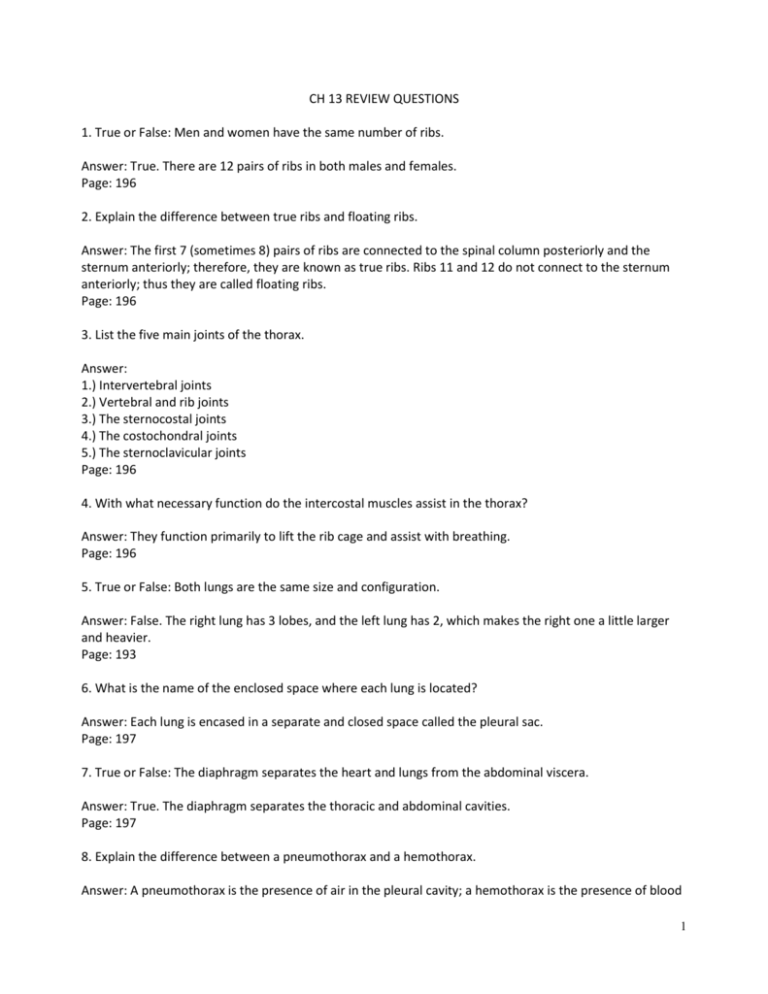
CH 13 REVIEW QUESTIONS 1. True or False: Men and women have the same number of ribs. Answer: True. There are 12 pairs of ribs in both males and females. Page: 196 2. Explain the difference between true ribs and floating ribs. Answer: The first 7 (sometimes 8) pairs of ribs are connected to the spinal column posteriorly and the sternum anteriorly; therefore, they are known as true ribs. Ribs 11 and 12 do not connect to the sternum anteriorly; thus they are called floating ribs. Page: 196 3. List the five main joints of the thorax. Answer: 1.) Intervertebral joints 2.) Vertebral and rib joints 3.) The sternocostal joints 4.) The costochondral joints 5.) The sternoclavicular joints Page: 196 4. With what necessary function do the intercostal muscles assist in the thorax? Answer: They function primarily to lift the rib cage and assist with breathing. Page: 196 5. True or False: Both lungs are the same size and configuration. Answer: False. The right lung has 3 lobes, and the left lung has 2, which makes the right one a little larger and heavier. Page: 193 6. What is the name of the enclosed space where each lung is located? Answer: Each lung is encased in a separate and closed space called the pleural sac. Page: 197 7. True or False: The diaphragm separates the heart and lungs from the abdominal viscera. Answer: True. The diaphragm separates the thoracic and abdominal cavities. Page: 197 8. Explain the difference between a pneumothorax and a hemothorax. Answer: A pneumothorax is the presence of air in the pleural cavity; a hemothorax is the presence of blood 1 in the pleural cavity. Page: 200 9. List the signs and symptoms of a costochondral separation. Answer: 1.) The athlete will report that a pop or snap occurred. 2.) A palpable defect may be felt because deformity may or may not be present; in addition, there may be swelling in the immediate area. 3.) Maximum or near-maximum inhalation may be very difficult. 4.) Localized pain and tenderness over the area of the costochondral junction. Page: 198 10. What is the best indicator of kidney damage or disorder? Answer: Hematuria Page: 201 11. True or False: The spleen is able to splint itself if injured by blunt trauma. Answer: True. The spleen has the capacity to splint or patch itself at the site of the injury because of its reservoir of red blood cells. Page: 201 12. Name the infection, prevalent among college-aged students, that causes the spleen to enlarge, requiring athletes to reduce physical activity until the spleen is once again normal. Answer: Mononucleosis Page: 201 13. What is a major cause of damage to the liver among collegiate athletes? Answer: Trauma Page: 201 14. List four functions of the kidneys. Answer: Maintain proper levels of waste, gas, salt and water and other chemicals in the blood stream. Page: 201 15. When pain occurs in the abdomen, what are some of the locations that the abdominal pain can be referred to? Answer: Shoulder tip pain (referred from diaphragm); epigastric pain (referred from esophageal problems); low back pain (referred from stomach problems); pelvic area pain (referred from lower back pain). Page: 202 16. Explain the best way to prevent bladder injury among athletes. 2 Answer: Avoiding injury to the bladder is best accomplished by emptying it before practice or competition. Page: 202 17. What are the two main organs in the thorax? Answer: The lungs and the heart Page: 197 18. What is the responsibility of the diaphragm? Answer: The diaphragm separates the thoracic and abdominal cavities. It is considered the main muscle of respiration. Page: 197 19. Define commotio cordis. Answer: When an athlete is hit in the chest and the impact is timed exactly with the repolarization phase of the contracting heart, it is possible for the athlete to experience ventricular fibrillation leading to death. Page: 199-200 20. List some of the preexisting conditions of the chest that may disqualify an athlete from participation. Answer: Hypertrophic cardiomyopathy, heart murmurs and arrhythmias, significantly decreased lung function from disease or disorder such as cystic fibrosis, or chronic obstructive pulmonary disease. Page: 202 3
